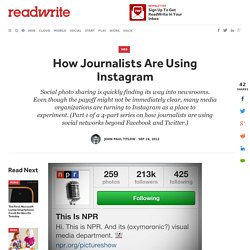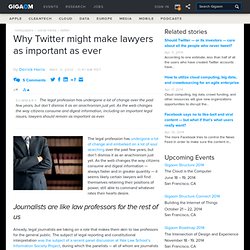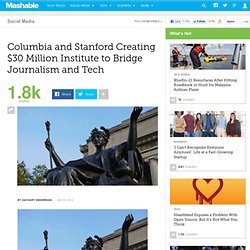

How Journalists Are Using Instagram. Social photo sharing is quickly finding its way into newsrooms.

Even though the payoff might not be immediately clear, many media organizations are turning to Instagram as a place to experiment. (Part 1 of a 4-part series on how journalists are using social networks beyond Facebook and Twitter.) Instagram's value to news organizations is less obvious than that of most other social networks. Facebook, Twitter and Pinterest can be used direct audience members to the publisher's site, but Instagram doesn't even encode URLs dropped in comment threads. How Journalists Are Using Pinterest. Journalist Dodges Bullets to Live-Tweet Taliban Attack. Twenty people were killed on Friday when Taliban fighters carried out an 11-hour-long siege of a lakeside hotel near Kabul, Afghanistan.

Mustafa Kazemi, a Kabul-based journalist who's becoming well-known for using Twitter to cover life and violence in the country, braved bullets and explosions to live-tweet the attack while it was unfolding. Below, check out Kazemi's riveting tweets and twitpics from the scene of the Taliban attack. Fittingly, Kazemi tweets under the handle @combatjourno. The Forbes Model For Journalism In The Digital Age. Since its founding in 1917, Forbes has been providing insights, information, and inspiration to ensure the success of those who are dedicated to the spirit of free enterprise.

Its flagship publications, Forbes and Forbes Asia, reach a worldwide audience of more than six million readers and its website, Forbes.com—the leading business site on the Web—attracts an audience that averages 30 million people per month. Forbes also publishes ForbesLife magazine and licensed editions in more than 25 countries around the world. Lewis DVorkin has always appreciated the importance of clarity, particularly in his professional life and in the media he consumes. When he first came to Forbes in the mid-1990s, he completely understood the brand and its voice. Then he left for AOL as the millennium turned. Two years ago, he sold that company to Forbes, one of his investors. Lewis DVorkin serves as Chief Product Officer at Forbes Media. Why Twitter might make lawyers as important as ever.
The legal profession has undergone a lot of change and embarked on a lot of soul searching over the past few years, but don’t dismiss it as an anachronism just yet.

As the web changes the way citizens consume and digest information — always faster and in greater quantity — it seems likely certain lawyers will find themselves retaining their positions of power, still able to command whatever rates their hearts desire. Journalists are like law professors for the rest of us Already, legal journalists are taking on a role that makes them akin to law professors for the general public.
The subject of legal reporting and constitutional interpretation was the subject of a recent panel discussion at Yale Law School’s Information Society Project, during which the panelists — all of whom are journalists who also have law degrees — seemed to agree there’s a big difference between presenting a legal argument to readers and presenting them with what they need or want to know. Can an Algorithm Write a Better News Story Than a Human Reporter? Had Narrative Science — a company that trains computers to write news stories—created this piece, it probably would not mention that the company’s Chicago headquarters lie only a long baseball toss from the Tribune newspaper building.

Nor would it dwell on the fact that this potentially job-killing technology was incubated in part at Northwestern’s Medill School of Journalism, Media, Integrated Marketing Communications. Those ironies are obvious to a human. But not to a computer. At least not yet. George Zimmerman Charged: How Journalists on Twitter Covered the Story. George Zimmerman has been charged with second degree murder in February’s shooting death of Florida teenager Trayvon Martin. Florida special prosecutor Angela Corey announced the charges at 6 p.m. ET. The alleged murder of Martin by Zimmerman has been trending online since the 17-year-old’s parents set up a Change.org petition to prosecute Zimmerman in their son’s death. The petition had 2,257,985 signees at time of this writing. The Huffington Post Wins Its First Pulitzer Prize. Francesco Franchi on Visual Storytelling and Representation vs. Interpretation.
Donating = loving Brain Pickings remains ad-free and takes hundreds of hours a month to research and write, and thousands of dollars to sustain.

To the BBC and others: Twitter is not your competition. Columbia and Stanford Creating $30 Million Institute to Bridge Journalism and Tech. Big news on the innovation front: Columbia Journalism School and Stanford's School of Engineering are teaming up to create an Institute for Media Innovation.

The Institute hopes to bridge the gap between journalism and technology and encourage collaboration between the two disciplines. The institute, officially called the David and Helen Gurley Brown Institute for Media Innovation, is made possible by a $30 million gift from former Cosmopolitan magazine editor in chief Helen Gurley Brown in honor of her late husband.
The gift will go towards funding two director roles — one in each university — as well as a physical space attached to Columbia Graduate School of Journalism complete with a high-tech newsroom. Facebook data: Thousands of journalists now have a Subscribe button.